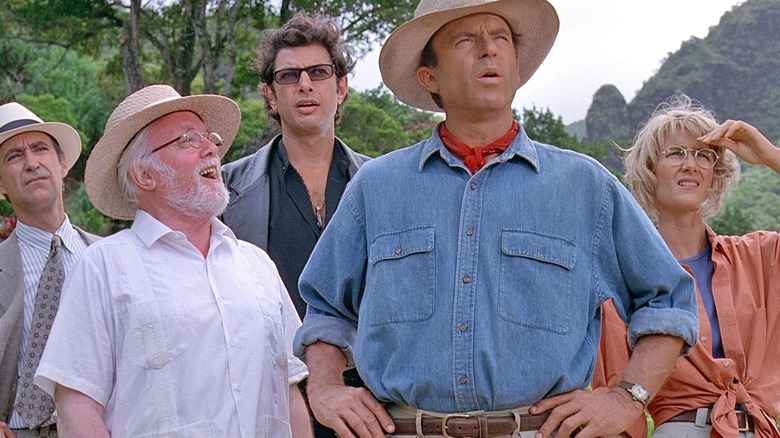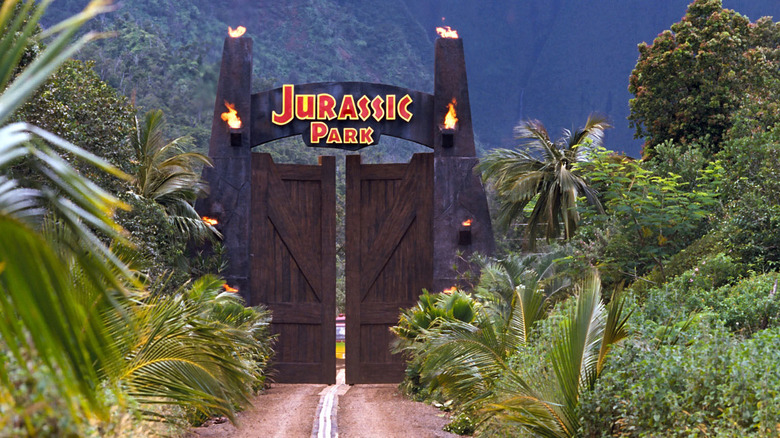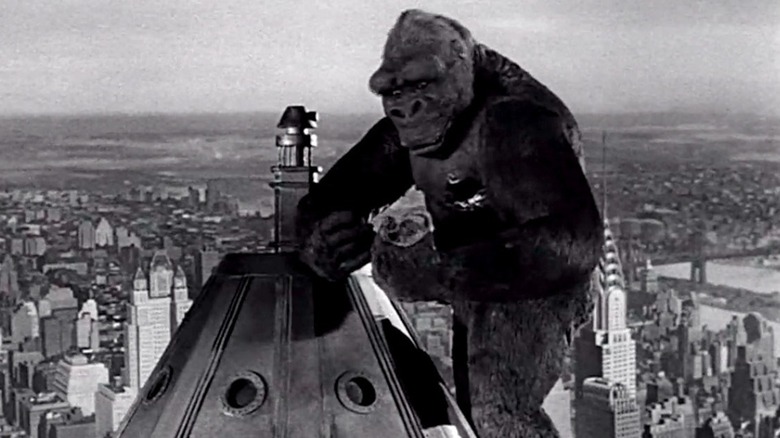
In Steven Spielberg's blockbuster classic "Jurassic Park," the first time Dr. John Hammond's test tour group enters the dinosaur theme park, they pull up to a towering gate with giant flaming torches on both sides. An overhead shot of their Jeep going through the massive entrance gives an ominous feeling and suggests that what lies beyond the walls is truly epic in size. The sardonic Dr. Malcolm asks, "What do they got in there, King Kong?" At first, this seems like an off-handed reference that demonstrates Dr. Malcolm's sarcastic skepticism, but looking closer, "Jurassic Park" has numerous ties to the 1933 classic "King Kong."
Both "Jurassic Park" and the many iterations of "King Kong" feature incredible but dangerous worlds where dinosaurs and other giant creatures walk the earth, brought to life by groundbreaking special effects teams. Isla Nublar, the location of the ill-fated theme park, and Skull Island, where Kong lives, take us back to a prehistoric time before humanity's rule. Both films caution audiences against taming nature, which will always win in the end. But it all begins with an obvious visual reference to "King Kong" during the scene when the test group first enters Jurassic Park.
The Jurassic Park Gates Homage King Kong

In the Netflix series "The Movies That Made Us," art director John Bell reveals that, when designing the Jurassic Park front gate, he was thinking of creating something fun and eye-catching like Disneyland. But director Steven Spielberg wanted it to actually look like the gate from "King Kong." The final product is a towering structure with torches coming out of the top. It still has that sense of theme park adventure, but there is a primitive, foreboding quality that hints at something massive and awe-inspiring lurking behind its walls.
The gate in "King Kong" evokes that same feeling and looks quite similar. It is part of the giant wall that the Skull Island natives build to safeguard them from the giant ape. Immensely tall and ominous, it reveals Kong's enormous stature when it opens; he fills the entire entrance and looks down on the puny humans. Later in the film, Kong is able to break the gate open in his pursuit of Ann despite a thick bar and group of men holding it shut.
Both of these gates tie into the theme of trying to contain Mother Nature. The dinosaurs escape and wreak havoc on Dr. Hammond's commercialized dinosaur playground, effectively ruining any chance of the park opening to the public. Meanwhile, Kong is cruelly stolen from his island home to perform in a Broadway show, only to break free and cause destruction before dying in the concrete jungle. There is no manmade force that can contain these wild, unpredictable beasts.
The gates play a key role in building up suspense for the big reveal of the giant creatures that are about to be unleashed. Once the doors open, audiences are meant to be amazed and frightened by what they see. But the gates have no meaning if there are not believable beasts behind them. In order to make their monsters convincing for audiences, the filmmakers of both "Jurassic Park" and "King Kong" had to use trailblazing visual effects.
Revolutionary Special Effects

"King Kong" and "Jurassic Park" share a legacy in revolutionizing special effects. Since their stories revolved around prehistoric creatures of massive size, the filmmakers needed to find creative ways to realistically portray them on screen.
Directors Merian C. Cooper and Ernest B. Schoedsack used special effects for "King Kong" in a way that had never been seen before during the 1930s. The monsters on Skull Island came alive from the use of stop-motion animation by Willis O'Brien. Stop-motion was a painstaking process that required meticulous lighting and set-up in order to make movements seem as fluid and consistent as possible. The famous fight between Kong and the Tyrannosaurus rex took seven weeks to finish, according to Inverse.
King Kong himself was an 18-inch puppet, and the special effects team built giant arms, hands, and feet for various shots, as well as a large head operated by cables and levers to manipulate his facial features for close-ups. In addition to stop-motion, the effects team used models and miniature rear projection. Traveling mattes were also employed, combining foreground action with a separately filmed background, which is especially important for all of the scenes where humans and Skull Island creatures interact.
Spielberg initially planned to use stop-motion in "Jurassic Park." In the behind the scenes feature "Return to Jurassic Park: Dawn of a New Era," the director explained where he got his inspiration:
"How we were going to get the dinosaurs to run, how we were going to get them to even be in the movie in wide shots, was always going to be the old-fashioned way through stop motion animation. The same way Willis O'Brien made King Kong."
In the end, Spielberg brought in special effects master Stan Winston to create the animatronic dinosaurs and Phil Tippett to use go-motion, a variation of stop-motion. The beautifully-detailed animatronics can be seen throughout the film, including the mammoth 40-foot long tyrannosaurus rex. But the dinosaurs made with go-motion still needed to look more fluid, so Spielberg looked at a CGI concept sequence that Industrial Light & Magic animators Mark Dippé and Steve Williams secretly made of a tyrannosaurus rex chasing a herd of gallimimus. This kind of computer-generated work had never been seen before.
The seamless mix of incredible CGI and elaborate animatronics is what makes "Jurassic Park" such a wonder to behold, even decades later. Spielberg pays loving homage to "King Kong" in his own version of a monster epic. Just like the makers of "King Kong," Spielberg changed the face of the moviemaking industry forever.
Read this next: 11 Spielberg Projects We Never Saw But Wish We Could've
The post Jurassic Park's King Kong Reference Isn't the Only Link to the Classic Monster Movie appeared first on /Film.
from /Film https://ift.tt/3yRu2fs
via IFTTT
Comments
Post a Comment